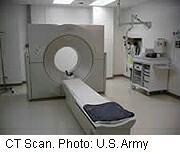
TUESDAY, Jan. 4 (HealthDay News) — Exposure to radiation from medical imaging procedures such as X-rays and CT scans has become common among American children, a new study has found, prompting researchers to call for steps to be taken to ensure appropriate use of the tests to protect children.
Increasing use of diagnostic imaging has led to concerns about radiation exposure. Although X-rays emit relatively little radiation, CT scans emit more and may raise the risk for cancer, particularly in children.
Compared with adults, infants and children are at higher risk for tumors because their developing tissues are more sensitive to radiation, the researchers noted.
For the study, Dr. Adam Dorfman, of the University of Michigan Medical School in Ann Arbor and his colleagues looked at the health insurance records of 355,088 children and teens younger than 18 for a three-year period, from the start of 2005 through the end of 2007.
In that time, 42 percent of the children had a scan that used radiation, the study found. Most of the 436,711 imaging procedures were done on children older than 10, but infants 2 years or younger also were given scans.
About 25 percent of the children had two or more scans, and 16 percent had three or more.
Most of the imaging procedures — nearly 85 percent — were X-rays, but CT scans accounted for about 12 percent. Scans of the head were the most common type of CT scan that was administered to children in the study.
“That’s particularly concerning,” Dorfman told the Associated Press. “Today’s children are undoubtedly getting many more of these studies than previous generations.”
Because of this, his team concluded in its report, “efforts to optimize and ensure appropriate use of these procedures in the pediatric population should be encouraged.” The findings were published online Jan. 3 in Archives of Pediatrics and Adolescent Medicine.
The Alliance for Radiation Safety in Pediatric Imaging, a coalition of imaging organizations, was formed specifically to work toward reducing unnecessary radiation exposure in children. For example, the group wants to make sure that children are given the lowest possible dose of radiation and that scans are done only when other tests that do not involve radiation cannot be used.
“We want to be as cautious as we can and protect children as much as possible,” Dr. Marilyn Goske, who chairs the alliance, told the AP.
More information
The Alliance for Radiation Safety in Pediatric Imaging has more about medical imaging procedures and children.

